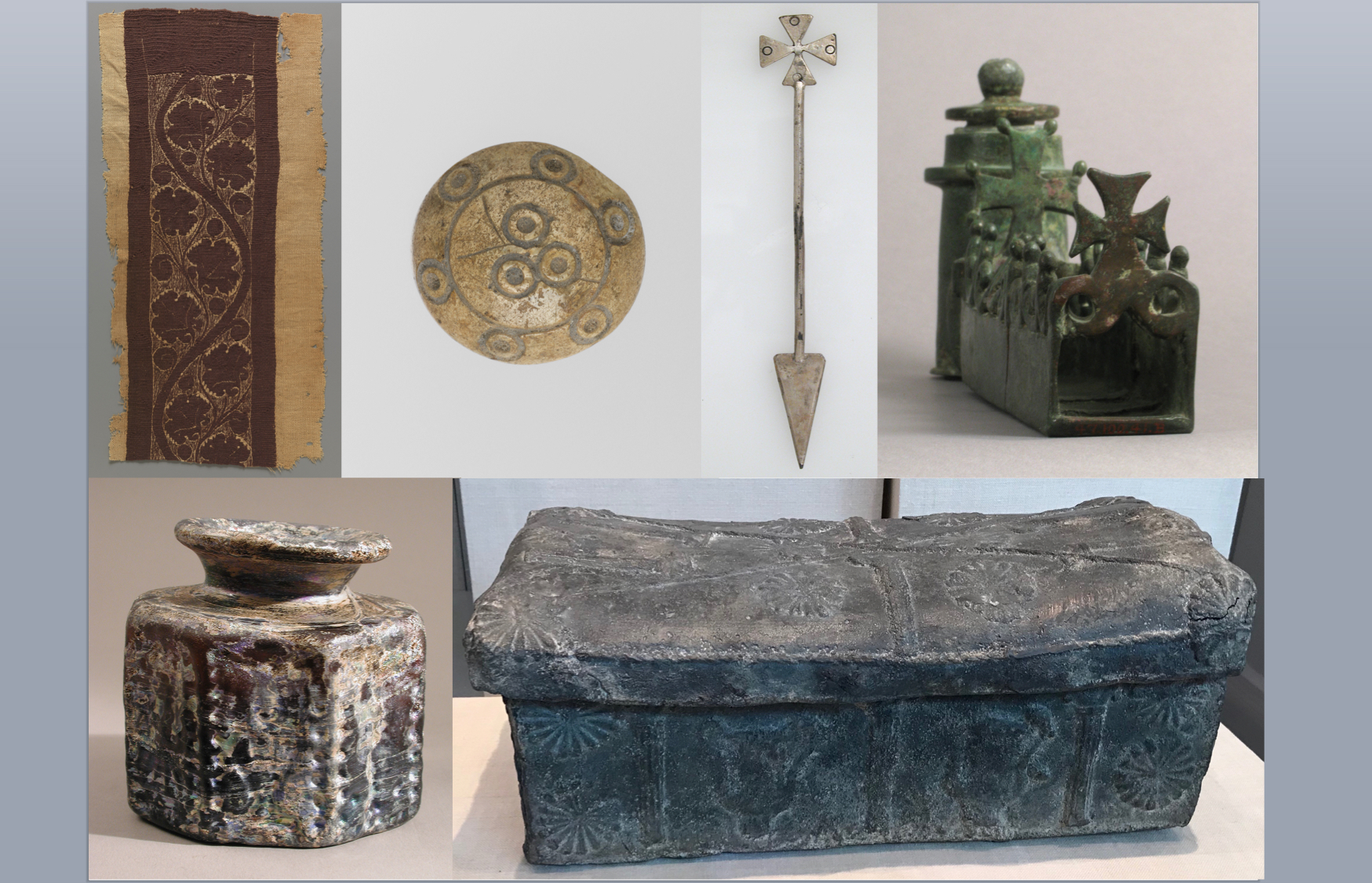Lead production in Britain expanded rapidly after the Roman conquest of CE 43. Ingots known as ‘pigs’ were produced for export, releasing huge quantities of lead pollution into the atmosphere, and possibly stunting the growth of those who grew up in the increasingly toxic environment. Even as British lead was sent around the empire, huge quantities of lead remained in the region and was used to produce some remarkable things that are rarely found outside Britain, including more than 300 lead coffins, mostly of the fourth century. Also remarkable are more than thirty lead vessels, variously interpreted as tanks, fonts, and caskets.

I have had the good fortune to examine three Roman lead vessels dated to the fourth century that are held at The Collection, Lincoln, United Kingdom. The Collection, formerly the Lincoln Museum, is the county of Lincolnshire’s archaeological repository.[i] These vessels are designated by their approximate findspots in northern Lincolnshire and their perceived forms as: the Walesby font, the Bishop Norton casket, and the Caistor casket.[ii] A second part of the Caistor casket is held at the British Museum, and a larger, third part once held at the British Museum is reported as having been stolen in 1950.[iii] I have received permission to examine the BM fragment, but have not yet done so.
The Walesby font, the Bishop Norton casket and the Caistor casket were all subjected to the same three non-destructive processes and analyses.[iv] First, they were scanned using white light and hand-held laser scanners, and the data registered to produce 3D visualizations and reconstructions.
Second, a Bruker portable x-ray fluorescence device was used to conduct basic non-destructive materials analysis.[v]
Third, the surfaces of each were examined carefully using a Crime-lite imager, focusing on the decoration, striations and cut marks on the tank and to produce high-resolution images. The imager employs 32 high efficiency LEDs to produce 98 light combinations, picking out detail that cannot be identified in regular lighting conditions.
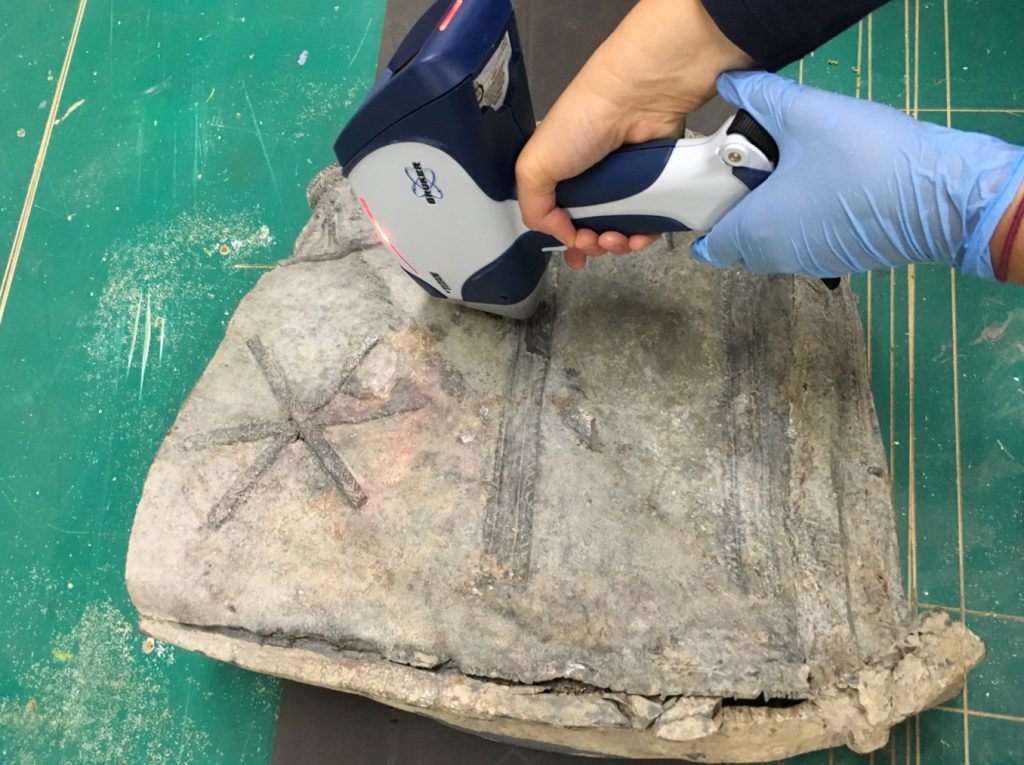
I was not able to conduct lead isotope analysis, since the additional information that would have provided does not, at this stage, appear to justify the expense of the minimally destructive process.
A large fragment of another lead vessel, closely related to that found at Bishop Norton, remains in private hands, but was brought to the The Collection Museum for study. Discovered in a north Lincoln suburb, this will be called the Ermine East casket. Fragments of three further inscribed lead caskets have been discovered in Nottinghamshire close to the modern county border with Lincolnshire, at East Stoke, at Brough, and just between them at Flawborough.[vi] Additionally, two pieces of a lead vessel were found at Calcethorpe, around 25 miles from Lincoln.[vii] I have not examined any of these fragments, but they have all been published, feature in short journal articles, or on the web site of the UK’s portable antiquities scheme.
Although we have only fragments, many of these vessels appear to have been polygonal and are inscribed with Latin phrases. Their shapes and inscriptions suggests that they were caskets and we might be tempted to consider them as a group; perhaps as the product of a single workshop, possibly in Lincoln; and certainly as distinct from a greater number of circular lead tanks found mostly in East Anglia.[viii] However, on closer examination, there are reasons to interpret each separately rather than to attempt to group them.
Let us start with the Walesby Font, which has been the subject of a lively discussion. It is considered most interesting for the figural scene, very rare, which appears to show baptism, and the Chi-Rho, which is rather more common. The Flawborough tank features four orant figures, the closest one comes to the figures on the Walesby font.
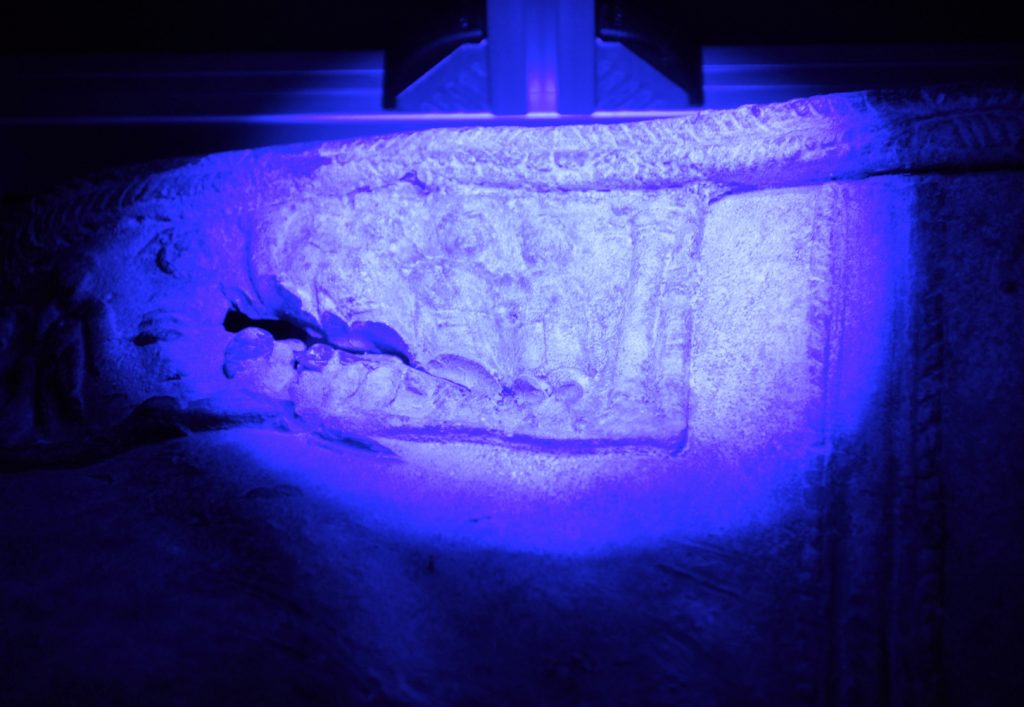
The Walesby font was discovered in two large pieces in autumn 1959 by a ploughman, H. Saunby, ploughing a field near Walesby, Lincolnshire. The two objects have been identified as the side (LCNCC: 1959.67.1) and part of the base (LCNCC: 1959.67.1) of a large Roman lead tank. The side piece, discovered first, was damaged by the plough, which unfortunately sliced right across a moulded frieze of figures. The base section was also ploughed up. The base does appear to be a segment of a circle. However, this is obscured by the way the two pieces were rather clumsily joined together shortly after their discovery.
They were exhibited as a single item at the Roman Society exhibition at Goldsmith’s Hall, London, 26 June to 22 July 1961.[ix] Together they suggest the vessels would have been 92cm in diameter, 55cm deep, and with a volume of approximately 360 litres. It is clear that the tank was deliberately and relative carefully cut into sections. However, there is no clear evidence of ritual or votive interment and there is no watery context for its discovery, considered significant in the interpretation of some findspots of Roman lead vessels.[x]
According to pXRF analysis, the Walesby font comprised 91.7% lead, with significant traces of Tin (Sn, 2.3%) and no silver. (I do not know how to explain the presence of two rare earth elements, Hafnium [Hf], a transition metal closely associated with Zirconium, and Tantalum [Ta], also a transition metal, other than by stating that pXRF analysis takes only surface readings so can throw up anomalies that further analysis would resolve.)

Other than the figural scene, the decoration is most closely related to that on the Calcethorpe fragments (LIN-E8F806), two pieces of a lead vessels discovered in 2004 around ten miles from Walesby. The Calcethorpe fragments were deliberately interred in a shallow oval pit. The rim of both fragments is decorated with a moulded single-cable band with incised chevrons and one fragment has a vertical double cable motif. Both designs are also found on the Walesby vessel.[xi]
The Caistor casket was discovered in 1863 as three separate side panels ‘in a crumpled mass, weighing over 50 lb.’, when a drain was being dug under the road west of the churchyard. One of these pieces ended up in the Lincoln Museum, today The Collection, Lincoln, while two were deposited at the British Museum.[xii]
The larger of the two pieces sent to London, which comprised around a quarter of the whole, was stolen from the British Museum in 1950.[xiii] Shortly before this, the corner piece was photographed and a good drawing of all three extant fragments was produced, showing that the largest, lost piece comprised a corner and parts of two sides and the base. No other part of the base has survived. The corner piece, at least, does not appear to have been painted, while the piece in Lincoln is a rusty orange colour, with the paint applied around the design and even in the notches of the rim.
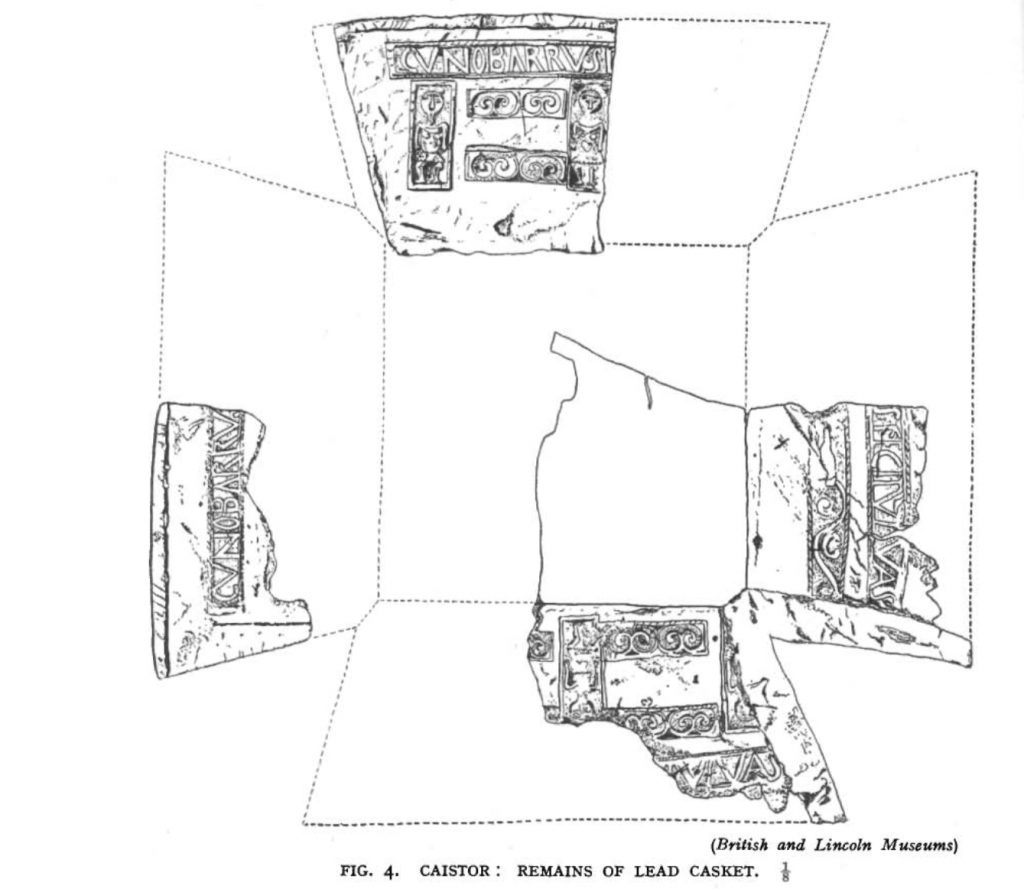
Based on its shape, Jocelyn Toynbee suggested a comparison with the Projecta Casket, part of the Esquiline Treasure, probably crafted in Rome in the later part of the fourth century. We do not know the shapes of the other caskets, having only parts of flat side panels.

There are apparent consonances with other caskets from near Lincoln, for example the confronted curls which echo the rather more fluid curling fern tendril pattern on the Bishop Norton fragment. This is far more apparent on the lost corner piece of the Caistor casket.
The Latin phrase within a box again is similar to but appears less delicate than that on the Bishop Norton panel. The presence of iron, at least at the surface of the metal, was identified in the pXRF analysis of the Caistor casket. In two locations iron appeared 3.3% and 4.3%, and when deliberately testing the coloured ‘rusty’ surface this rose to almost 14%. This surely relates to the colour applied to the surface of the vessel, perhaps an iron oxide pigment in the paint. Otherwise, the pXRF suggested a very similar composition for this metal as for the Walesby font, being 91.6% lead, 2.5-2.7% tin, and no silver (again, with similar readings for Hf and Ta). The pigment can be ‘removed’ under certain lighting conditions.
The Caistor casket deserves further research, including who painted it, when and why. I shall have a chance to examine another part of it in the British Museum, and to read their accession notes. I regret that this was not possible before now.
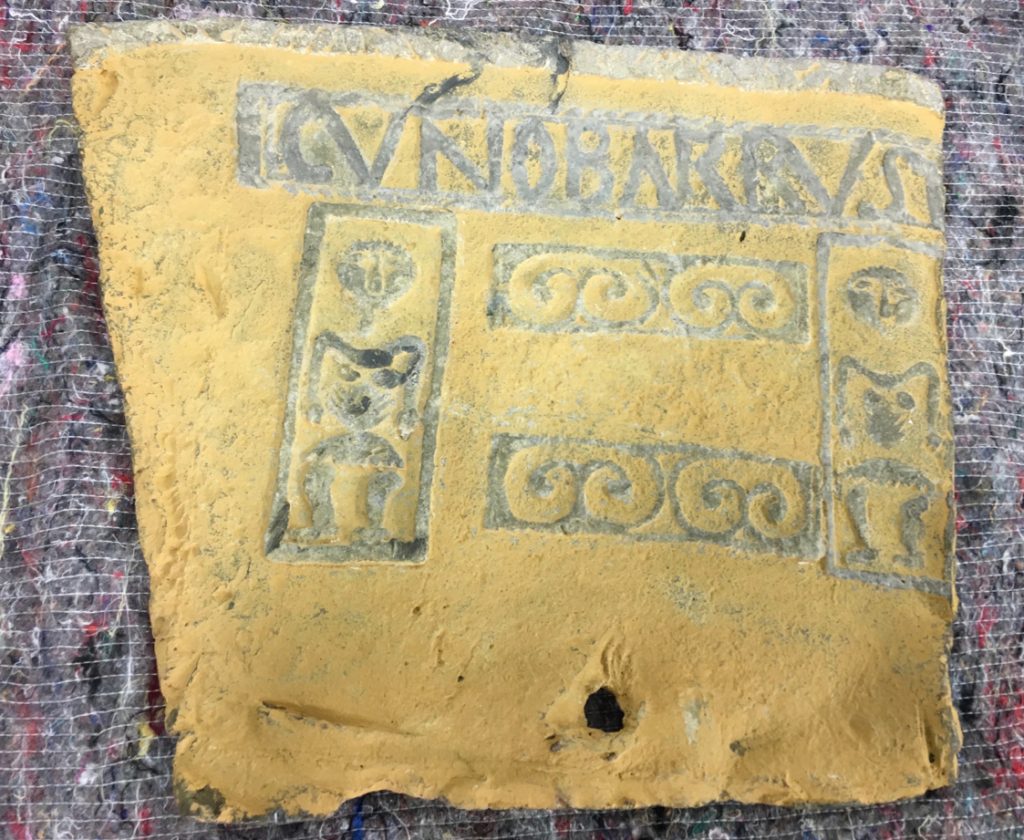
One part of the Bishop Norton casket, a side panel, was discovered in 1946, ‘ploughed up on Low Farm, Bishop Norton, 13 miles north of Lincoln and one mile east of Ermine Street’.[xiv] It was found by John Taylor and donated to the Lincoln Museum. ‘While ploughing the same field in 1955, Mr Taylor’s brother William turned up what must be part of the undecorated base of the same vessel. So far as he could judge the find was in the same spot as his brother’s’.[xv] This was also donated to Lincoln Museum. An inspection of the latter findspot by members of the Lincolnshire Architectural and Archaeological Society revealed some sherds of second- to fourth-century ‘Romano-British pottery … though not in large quantities’.[xvi]
The lead content of this casket was slightly greater than the other two analyzed, at 93.2-93.5%, and the tin rather lower at 0.5%. Once again there was no silver at all (but there were similar amounts of Hf, at 3.7%, and Ta, at 0.7-0.8%), which suggests this is desilvered lead.
Quite why this vessel and others like it, or unlike it, were deliberately buried, rather than recycled, is an open question. Suggestions include ritual decommissioning of sacred objects, such as a baptismal font, and hoarding for later collection and reuse.
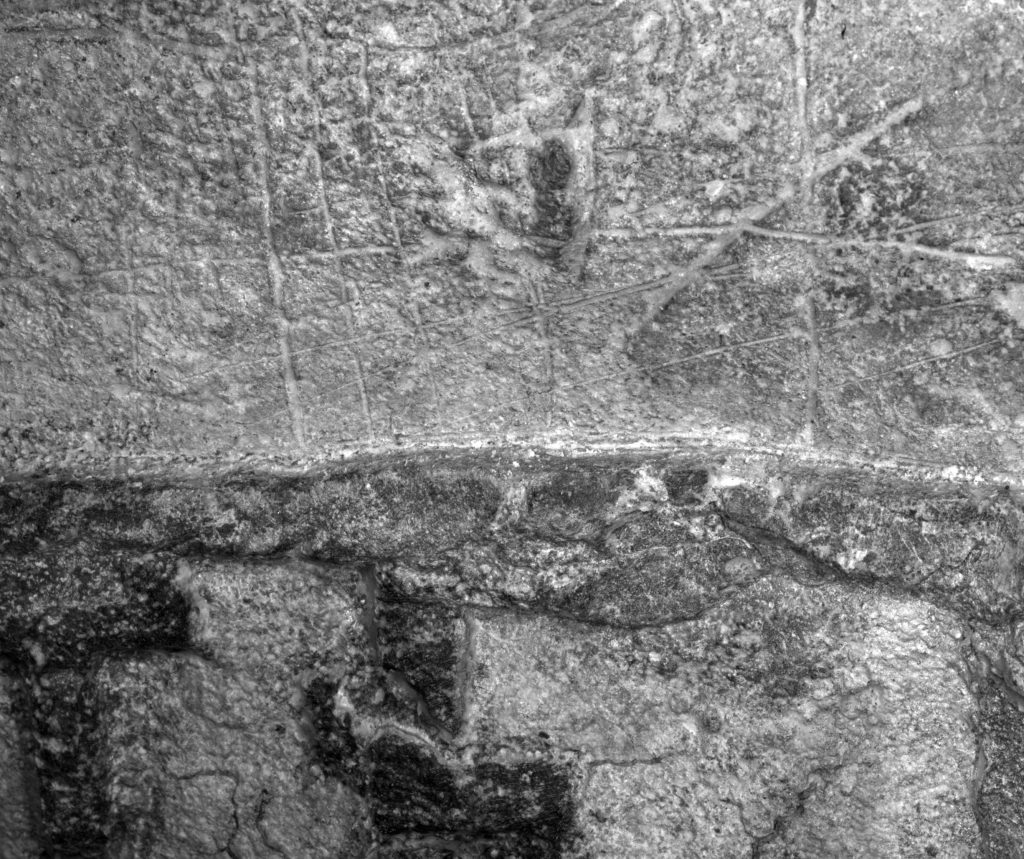
The inscription, which is missing its beginning but is complete at the end, reads DOFECITFELIX. This really must now be compared with the Ermine East casket (LIN-9C11F6), a large fragment examined at The Collection, which has an inscription that reads: MELEDOFECITFELIX. This fragment has since been returned to its owner, and is not available for further study. The inscription could be read ‘Felix made [this] for Meledus’ [Meletus?]. Felix was a common cognomen, particularly among slaves and freedmen. However, given the ubiquity of the term ‘felix’ on objects discovered in Roman Britain, it is far more likely to be communicating good luck to those who used it. For example, a late third-century green glass bottle, discovered at Faversham, Kent, and now in the British Museum has on its base simply ‘FELIX FECIT’. Hence, the inscription surely means ‘Meledo made [this] gladly’, or ‘Meledo made [it], good fortune’. Meledo as a nominative is possible, and we have dozens of examples of native Britons whose names ended in ‘o’.
Other lead vessels bear the inscription ‘Vtere felix’, meaning ‘good fortune to the user’ or ‘use happily’. This is a common inscriptional formula on objects from Roman Britain, for example on an incomplete copper alloy knee brooch (LIN-C355C3) discovered in Lincolnshire, or more clearly on an enameled bronze vessel from Yorkshire (YORYM-20B68C). A golden bracelet discovered as part of the Hoxne (pr. Hox’n) treasure (British Museum 1994,0408.29) reads VTERE FELIX DEMINA IULIANE.[xvii]
The phrase VTERE FELIX is not explicitly Christian, but it is frequently associated with symbols identified as Christian.[xviii] The Flawborough lead vessel has VTERE FELIX at its rim with four figures orant, their hands raised to heaven, and the Chi-rho symbol. The East Stoke lead vessel has VTERE EELIX in combination with a Chi-rho, and note the mistake of E for F, which also seems to feature on the Ermine East casket, where the bottom of F in FELIX is not quite a full E.
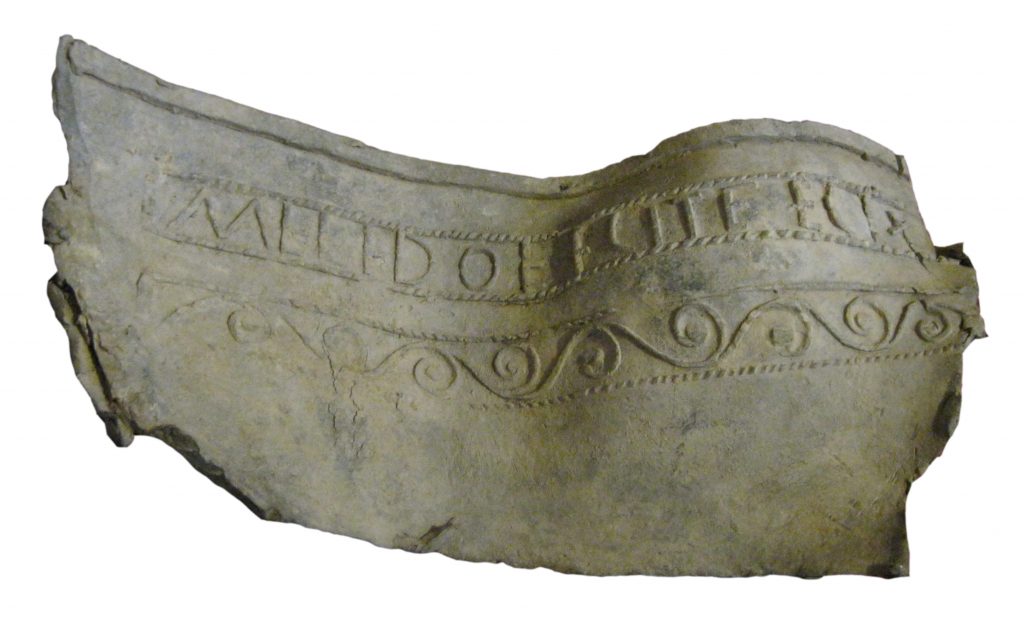
All of these lead vessels, tanks and caskets, support the notion that there was a lead workshop in the city of Lincoln or very close to it. An alternative suggestion, worth consideration, is that an itinerant lead worker travelled to manufacture the caskets for their owners in situ, but this would require having the space and equipment locally to dig a large suitable trench, transporting enough lead and sand or clay to that location, plus equipment for melting and pouring lead (a crucible, tongs, etc.), plus materials for design and lay-out and the time it took for all stages, including setting, finishing, etc. Finally, of course, one needed a decent furnace.
I do not, however, propose that this was the work on one person. Some clearly were produced together and by the same artist, for example the Bishop Norton and Ermine East caskets. Others may have been by the same artist, for example the Walesby font and Calcethorpe vessel, and perhaps the East Stoke vessel. Similarities between other vessels, such as the Bishop Norton and Caistor caskets may be explained by the familiarity of an artist with an existing piece. It seems most sensible to suggest, therefore, that the vessels are witness to an active habit of making in lead that flourished throughout the fourth century in the east of England, and that several artists were active over that century in or near Lincoln.
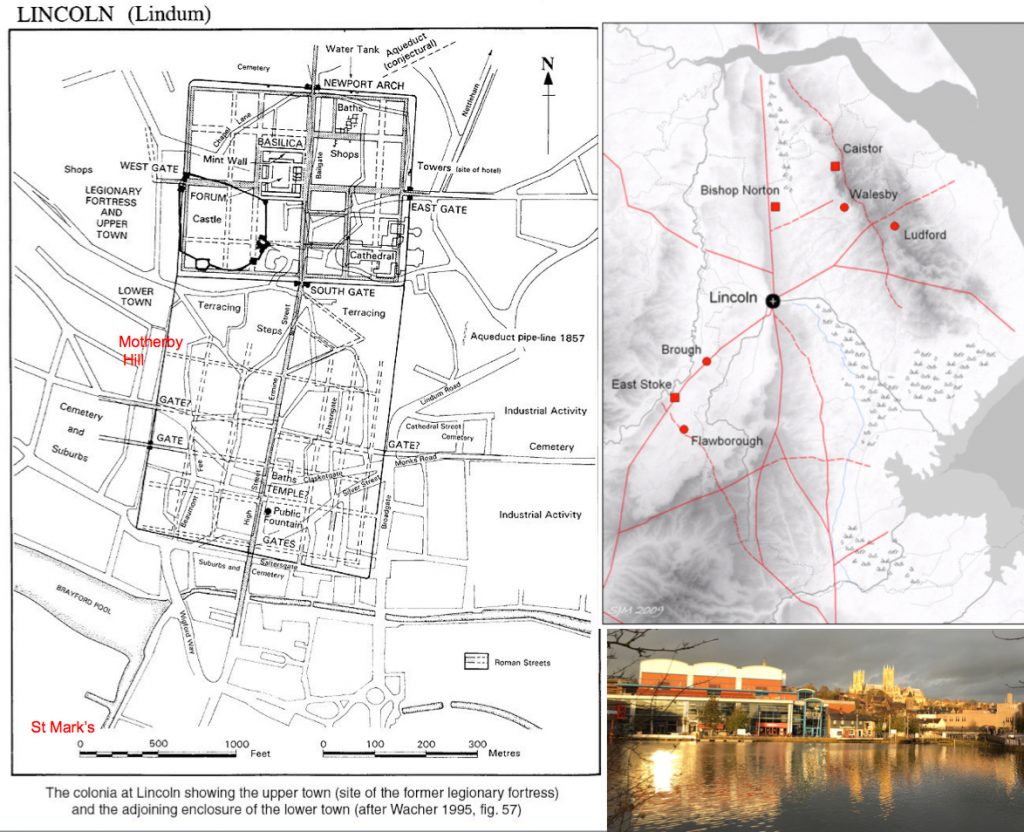
Scrap or salvaged lead could have been melted down using a good domestic hearth, and smelting could have taken place any of the many small smithing furnaces scattered across Roman Lincoln, for example at a mid-Roman smith identified to the south of the river Witham, at what was later St Mark’s station (excavated after its closure in 1985, the site is now a shopping mall), or another at the adjacent site of the later St Mark’s Church.[xix] Additionally, a domestic hearth modified deliberately and specifically for lead working in the late fourth or early fifth century has been discovered.
In a house abutting the walls of Lindum Colonia, at a location today called Motherby Hill, a domestic oven (measuring 4’10” by 5’6”; 1.45×1.65m) was excavated. The flue to the oven had, very late in its life, been narrowed to only 10” (25cm) by the insertion of stones set in clay, which would have allowed it to reach greater temperatures. This new furnace was not used frequently: there were no ashy cinders and no build up of soot in the flue. Instead, the flue was covered in a solidified flow of lead. This has been interpreted as evidence that a crucible had been suspended within the flue to melt down recycled lead, but this had cracked and dispensed lead across the furnace, rendering it unusable.
However, if only recycled lead was being melted, then the domestic hearth would not have needed to be modified. There are two other possibilities. First, and less likely, galena might have been smelted in this oven, since the ore is best ‘roasted’ near the top of a furnace, where it will more easily oxidize. The sulphur dioxide would be expelled as gas through the flue and the lead would fall to the bottom of the furnace.[xx] However, it seems more likely that the modification to the furnace represented an attempt to remove any remaining silver from the lead. The lead from the flue was analyzed with an XRF, which showed it comprised 99.78% lead, 0.11% silver, and 0.10% tin. Although the silver content may appear very low, it is in fact by far the highest ever recorded for Romano-British lead, the next best being 0.056% in a lead ingot from Somerset.[xxi] This, and the presence of tin, makes it likely that the lead being melted in the cracked crucible came from the Mendips, or even a source outside Britain, and not nearby Derbyshire. Having failed as a lead furnace, the oven was demolished. In the debris were found several scraps of lead sheet and a single coin of Valens (AD 367-75). Additionally, a number of heat-distorted lumps of lead were found in the debris (level 5) and in a later layer (level 6) of dumped rubbish on top of demolished furnace. It is interesting to find such clear evidence for lead working in Lincoln at the end of the fourth century or slightly afterwards.
Notes
[i] We acknowledge gratefully the help: of staff at The Collection, especially Antony Lee, who arranged for the tanks to be taken off display for study and participated at every stage in the analysis; of staff at the British Museum who supported our analyses of the Caistor fragment in their care, and especially Rachel Wilkinson who tracked down notes and two photographs of the stolen portion of that casket.
[ii] RIB II.2, 66 (2416:4: Caistor), 67 (2416.7: Bishop Norton). See also RIB II.2, 71 (2416.14: Walesby); J. M. C. Toynbee, Art in Britain under the Romans (Oxford, 1964), 353-6; C. Thomas, Christianity in Roman Britain to AD 500 (London, 1981), 221-5.
[iii] Toynbee 1964, 350, records the theft, which is missed at RIB II.2, 66. Rachel Wilkinson confirmed this fact, noting that the larger missing piece was photographed, but not formally registered at the British Museum.
[iv] Michael Poole and Kevin Hallsworth helped with white light laser scanning and processing, Philippa Hoskin and Hollie Morgan lent and operated the Crime-lite imager, Melina Smirniou helped with the pXRF and tabulated the data. All were, at the time, employed at the University of Lincoln.
[v] We considered conducting lead isotope analysis, such as that described in Trincherini et al. 2009, which would have identified more accurately a source for the lead, but concluded that neither the (minute) damage to the objects nor the expense was warranted, given how little additional information of significance for our commentary would be supplied by knowing the exact source of the ore within Britain, and how likely it is that the source of lead was Derbyshire. However, this is a desideratum for further study. Isotope analysis of lead ingots, in particularly, would allow a better understanding of the distribution and uses of British lead in the Roman world. Cf. M. Bode, A. Hauptmann and K. Mezger, ‘Tracing Roman lead sources using lead isotope analyses in conjunction with archaeological and epigraphic evidence – a case study from Augustan/Tiberian Germania’, Archaeological and Anthropological Sciences 1 (2009), 177-94, which is useful for demonstrating the German origin of ingots marked as PLUMBUM GERMANICUM, since lead production in that region was not abundant and most evidence (142 of 145 known ingots) comes from two Roman shipwrecks in the Mediterranean. Fruitful new research in this area is underway, including the development of new non-destructive methods: M. Clemenza et al, ‘Development of a multi-analytical approach for the characterization of ancient Roman lead ingots’, Journal of Radioanalytical and Nuclear Chemistry 311 (2017), 1495-1501.
[vi] RIB II.2, 68 (2416.8: East Stoke; also plate 6B). The East Stoke tank was first recorded in a note (15. East Stoke) by R. P. Wright, contained in ‘Roman Britain in 1954: I. sites explored; II. Inscriptions’, Journal of Roman Studies 45 (1955), 121-49, 147. The other tanks were discovered after the RIB was completed: D. J. Watts, ‘A lead tank fragment from Brough, Notts. (Roman “Crococalana”)’, Britannia 26 (1995), 318-22; L. Elliot and S. Malone, with R. Leary, ‘Iron age/ Romano-British features and a fourth-century lead tank from Flawborough, Nottinghamshire’, Transactions of the Thoroton Society of Nottinghamshire 109 (2005), 25-43.
[vii] A note by S. Worrell at ‘Roman Britain in 2004’, Britannia 36 (2005), 383-446, 454.
[viii] C. J. Guy, ‘Roman circular lead tanks in Britain’, Britannia 12 (1981), 271-6, knew of twelve examples; D. Watts ‘Circular lead tanks and their significance for Romano-British Christanity’, Antiquaries Journal 68 (1988), 201-22, records two new finds, making ‘at least seventeen known finds’. The number continues to rise, hence B. Crerar, ‘Romano-British lead tanks: a study in design, destruction and deposition’, Britannia 43 (2012), 135-66, surveys twenty-eight lead vessels discovered in Roman contexts, not including the Ermine fragment, but including both the Caistor and Bishop Norton caskets, which ‘differ conspicuously in shape from the other tanks, but enough similarities exist regarding their size, manufacture, decoration and manner of disposal to suggest that they are simply variations on the common circular model’. We have determined to distinguish polygonal vessels (caskets) from circular vessels (tanks).
[ix] J. Toynbee, Art in Roman Britain (London, 1962), 181-2, catalogue no. 133; plate 143.
[x] D. Petts, ‘Votive deposits and Christian practice in Late Roman Britain’, in M. Carver, ed., The Cross goes North (York, 2003), 109-18, proceeds swiftly from one predicate to another in using various vessels as evidence for Christian ritual deposition: ‘the consensus is that they were involved in some manner in the rite of baptism’; ‘The tanks were mainly found in Eastern England …’; ‘the deposition of the lead tanks may itself have been a ritual practice favoured in East Anglia, thus skewing the distribution of Christian attributes’. We cannot agree that there is sufficient evidence in Lincolnshire or Nottinghamshire to support his observation that ‘the importance of these lead tanks may have been as much in their deposition as their use. It is clear that whatever their primary use the deposition of the fonts is part of a wider phenomenon of ritual deposition in late Roman Britain’.
[xi] A note by S. Worrell at ‘Roman Britain in 2004’, Britannia 36 (2005), 383-446, 454.
[xii] C. Hawkes, I. Richmond and V. Nash-Williams, ‘The archaeology of Lincolnshire and Lincoln: the Roman occupation’, Archaeological Journal 103 (1946), 16-84, 23-5. There is no evidence for a ritual or votive deposition in a well or watery site in the manner advanced as typical by Petts 2003.
[xiii] Toynbee 1964, 355.
[xiv] Notice in Journal of Roman Studies 37 (1947), 180-1. A footnote gives the exact findspot as ‘field no. 123 (O.[rdnance] S.[urvey] 25 in. map XLIV, 4) one mile due east of Bishop Norton and south of stone-pit Road’.
[xv] Notice in Lincolnshire Architectural and Archaeological Society Report and Papers (1956), 9-10.
[xvi] LAASRP 1956, 10. There was no evidence for a ritual or votive deposition and no water nearby.
[xvii] Raybould, p. 140, cited at Wikipedia on Hoxne hoard, as second most common inscription on finds from Roman Britain. A gold signet ring in the Victoria and Albert Museum (502-1871), probably of the second century, bears the inscription ITERE FELIX, either a mistake for VTERE FELIX, or wishing the wearer a safe journey.
[xviii] E. Morvillez, ‘La fontaine Utere Felix de carthage, une installation de banquet de antiquité tardive et son décor’, Antiquité tardive 15 (2007), 303-20. The phrase was so well known that abbreviations were common, as were spelling mistakes. Two silver rings, found separately in Norfolk late in 2000 (NMS107; NMS180), both bear the inscription VTI FELIX. A small gold signet ring discovered at Lydney, Gloucestershire (GLO-988544) bears only the abbreviation VF, as does a tinned or silvered copper alloy strap fastener (NMS-FF92F5) discovered at Brancaster, Norfolk. A copper alloy spoon discovered near Darlington has FELIX inscribed in red enamel on its handle (NCL-CCC324).
[xix] The Archaeology of Wigford and the Brayford Pool, eds. K. Steane et al., Lincoln Archaeological Studies 2 (Oxford, 2001), pp. 182-4, 226, 268.
[xx] Tylecote, ‘Roman lead working’, 28-9.
[xxi] Defences of the lower city, eds Coyer et al., pp. 195-8, 236, 249; Tylecote, ‘Roman lead working’, 38. A final, possibility, rather less likely, is that lead was being used to refine silver in a cupel.
